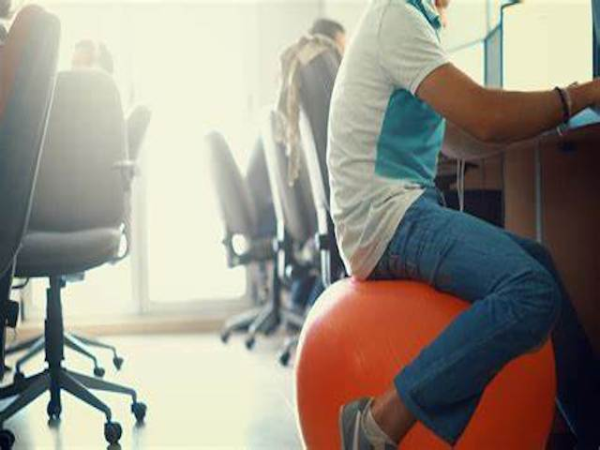Numerous studies have shown that prolonged sitting is associated with increased risk of health issues. [1] If you are experiencing stiffness or soreness in your back, these signs and symptoms are not to be overlooked.
In this article, we will help you understand the common causes of back pain from too much computer screen use and ways how to overcome it.
Common Causes of Office Back Pain

Are you using a traditional office chair and spending most of your day sitting? Read on while we discuss the common causes of back pain sustained by office workers. You may be experiencing discomfort in your abdominal and back muscles that require attention.
Prolonged sitting
If you are not sitting comfortably in your chair, you can start to experience aches and pains. Prolonged sitting adds a lot of pressure to your lower back. Continuing this for long periods will cause your body to develop poor habits.
Imagine a piece of rubber band stretched over a period of time. After letting go of the rubber band, most of the time it does not go back to its original shape. This is because the rubber band has been overstretched. This happens to ligaments in our bodies.
If we continue to stress our ligaments for long periods of time eg. sitting in the same position, loading our ligaments will cause hysteresis. Research has shown that this results in mechanical functional degradation over time. [2]
Poor sitting posture
Poor sitting posture in an office chair can cause problems to your back. Slouching, hunching over in front of your computer screen, or leaning to one side can significantly put additional strain on your muscles, spinal ligaments, and joints. When you slouch forward, this often causes additional pressure in your neck. You can develop tightness at the front of your chest and muscle weakness in your back. Over time, the risk of developing lower back discomfort increases with prolonged sitting with a hunched posture. [3]
Incorrect ergonomics
When your workplace has not been set up properly, this places your body at risk of injury. With the option of working from home nowadays, it is important to have your workstation checked and set up ergonomically.
Invest in an ergonomic chair. Check that the desk height, chair height and position of your computer monitor is set up appropriately.
Lack of exercise
Avoid a sedentary lifestyle to maintain optimal body health. Keep muscles strong, joints flexible, and posture aligned through regular movement and activity.
There are many simple exercises that you can perform independently at home. Exercises that promote spinal and joint mobility as well as postural exercises are great exercises to start off with.
Poorly designed furniture
Improper types of furniture can also contribute to poor posture.
Ensure proper ergonomics in your workspace to protect your body. Address issues like inadequate lumbar support, ill-fitting desks, and non-adjustable workstations to prevent potential negative impacts on your posture and overall well-being.
It is recommended to invest in well-designed pieces of furniture that promote proper alignment and provides ergonomic support that can help your body avoid slouched position for an extended period.
How to Prevent Back Pain When You Sit All Day

Use proper ergonomics
Understanding the importance of having proper ergonomics can help you prevent a trip to your doctor.
Here are some tips to consider:
-
-
Adjust your chair so that your feet lay flat on the floor
-
-
-
Keep your knees at a comfortable 90-degree angle to minimize tension around the joints
-
-
-
Use an ergonomic office chair that provides good support for your lower back muscles
-
-
-
Position your computer screen at eye level so you don’t strain your neck or cause stiffness after a long period
-
You can always opt for a Swedish kneeling chair depending on your preferences and workplace setup.
Take frequent breaks
Getting regular breaks from time to time can help you prevent sitting for prolonged periods. Research is also suggesting that breaking up prolonged sitting periods may improve one’s cognitive function. [4]
This approach can help you relieve the soreness and pressure on your back.
Maintain good posture
Remember to sit up straight, with your shoulders relaxed and your back aligned to be able to maintain good sitting position.
Avoid slouching or hunching forward to prevent you from experiencing discomfort in your upper back. On the other hand, you can place a cushion or a rolled-up towel around your lower back to provide back support.
Get professional medical advice if you are experiencing pain.
Incorporate core strengthening exercises
Being able to build your core muscles can provide valuable support to your spine.
Include core exercises like planks, bridges, or abdominal crunches into your routine. A few sets can improve your muscle strength.
If you’re unsure what exercises are right for you, consider consulting a physiotherapist.
Stretch regularly
Take a moment throughout the day to perform gentle stretches. This can help relieve tension and improve flexibility.
Twisting your spine or doing neck stretches can be beneficial. Consult our Doreen physiotherapist to get a personalised exercise program that you can do at home. Get a list of exercises that you can easily incorporate into your daily routine.
This will enable you to do your exercises more consistently. You can also try other relaxation techniques to improve body awareness and flexibility.
How to Set Up an Ergonomic Workspace at Home
When it comes to setting up your workspace, there are a few key things to keep in mind for a comfortable and ergonomic setup.
Choose the right desk and chair
Consider getting a desk and chair that is height adjustable. This way you will be able to customize your workstation to suit your needs. Furthermore, an adjustable desk gives you the flexibility of standing up and sitting down throughout the day.
Choose a chair that offers back and neck support. This will help improve posture while sitting at your desk. Having neck support will keep your head upright rather than slouching forwards.
Position Monitor
It’s important to have your monitor directly in front of you at eye level. This helps maintain good posture and reduces strain on your neck and eyes.
Make sure the screen is about an arm’s length away from you, and adjust the tilt and height of the monitor so that the top third of the screen is at your eye level.
Setup keyboard and mouse
Position them in a way that allows your upper arms, and wrists to be in a relaxed and neutral position.
Your keyboard should be at a height where your elbows are at roughly a 90-degree angle, and your wrists should be straight. Have everything within arm’s reach to avoid reaching and straining.
If needed, you can use a wrist rest for added support.
Arrange chair and desk height
Adjust your chair so that your feet can rest flat on the floor or on a footrest if necessary.
Your knees should be at a comfortable 90-degree angle, and your thighs should be parallel to the floor.
The height of your desk must be compatible with your chair. This will help your arms to rest comfortably on the desk. Observing proper posture alongside practicing body awareness and participating in core exercises will minimize the chance of injury. [5]
Position arms and wrists
When typing or using the mouse, keep your head facing forward, forearms parallel to the floor and your wrists straight.
Avoid resting your wrists on the edge of the desk and try not to put too much pressure on the keyboard or mouse to prevent discomfort around these areas.
Using an ergonomic keyboard and mouse can be helpful in maintaining a more natural hand and wrist position while working.
Maintain good posture
Maintaining good posture is important especially if you have a desk job.
Sit up straight and align your head, neck, and spine in a neutral position.
Try to avoid slouching or leaning forward most of the time. Engaging your core muscles slightly while standing or sitting can also help stabilize your spine and promote better posture.
Ensure you take a break every half hour. Simply stand up, walk around or change positions regularly.
Take regular breaks
Even with the best ergonomic setup, it’s important to give your body a break. Use your free time to relax and find a comfortable position.
This helps prevent muscle fatigue due to constant pressure and at the same time, improves blood circulation.
What Else Can Help with Back Pain from Sitting at a Desk?
Adding a lumbar support cushion can help maintain the natural curve of your lumbar spine [6]. It can relieve the pressure and improve your sitting posture.
You can also apply a hot pack to your back. This can help induce blood flow, and provide muscle relaxation. [7]
Additionally, having a standing desk in your workplace allows you to move freely. You can sit or stand while working.
Also, swapping your chair for a stability exercise ball, or a medicine ball can engage your core muscles. It also helps in improving your balance and stability which is good for your health.
Some case studies recommend sitting on a Swiss exercise ball to promote active sitting, which keeps your core muscles activated and can help alleviate back pain. [8]
Stay Active To Reduce Back Pain in the Office

Simple exercises such as trunk rotation, shoulder rolls, core stabilization exercises and deep neck flexor training can help you relieve pain. [9]
Staying active is vital. Having short walks during your meal breaks and stretching your legs from time to time can go a long way when it comes to looking after your health.
Remember to change positions regularly, take breaks to stretch and exercise. Your back will thank you and all your discomfort will be gone in no time! If you are having niggling back pain, see one of our local physio for treatment and get yourself some physiotherapy exercises you can perform at home.
References:
- Biswas et al; Sedentary Time and Its Association With Risk for Disease Incidence, Mortality, and Hospitalization in Adults. A Systematic Review and Meta-analysis. Annals of Internal Medicine (2015).
- Solomonow; Ligaments: A source of musculoskeletal disorders. Journal of Bodywork and Movement Therapies (2009).
-
Jung et al; Effects of Prolonged Sitting with Slumped Posture on Trunk Muscular Fatigue in Adolescents with and without Chronic Lower Back Pain. Medicina (2020).
- Chandrasekaran et al; Does breaking up prolonged sitting improve cognitive functions in sedentary adults? A mapping review and hypothesis formulation on the potential physiological mechanisms. BMC musculoskeletal disorders (2021).
-
Huxel Bliven et al; Core Stability Training for Injury Prevention. Sports health (2013).
-
Grondin et al;The effect of a lumbar support pillow on lumbar posture and comfort during a prolonged seated task. Chiropractic & manual therapies (2013).
-
Freiwald et al; A Role for Superficial Heat Therapy in the Management of Non-Specific, Mild-to-Moderate Low Back Pain in Current Clinical Practice: A Narrative Review. Life (2021).
-
Merritt et al; The gym ball as a chair for the back pain patient: A two case report. The Journal of the Canadian Chiropractic Association (2007).
-
Gumuscu et al; Comparison of three different exercise trainings in patients with chronic neck pain: a randomized controlled study. The Korean Journal of Pain (2023).
